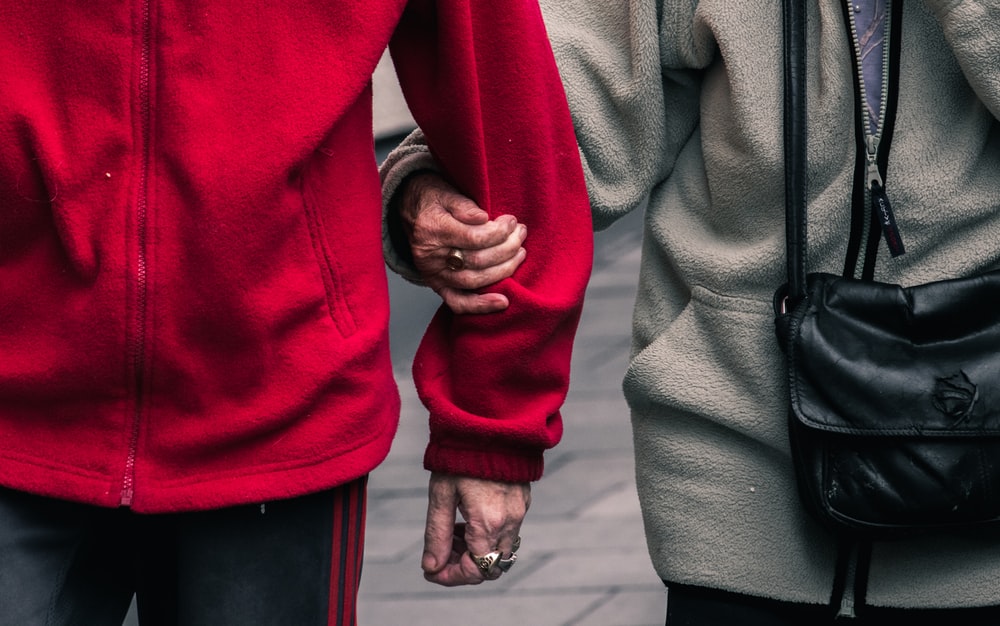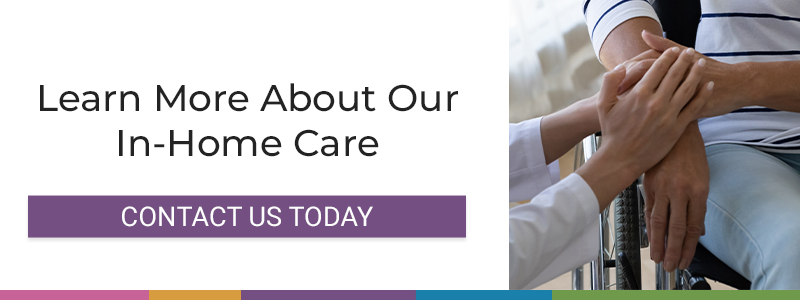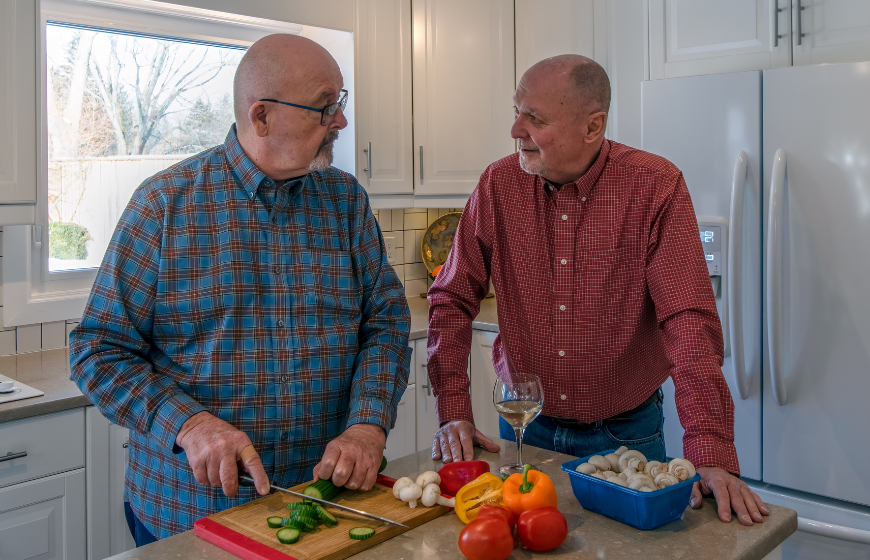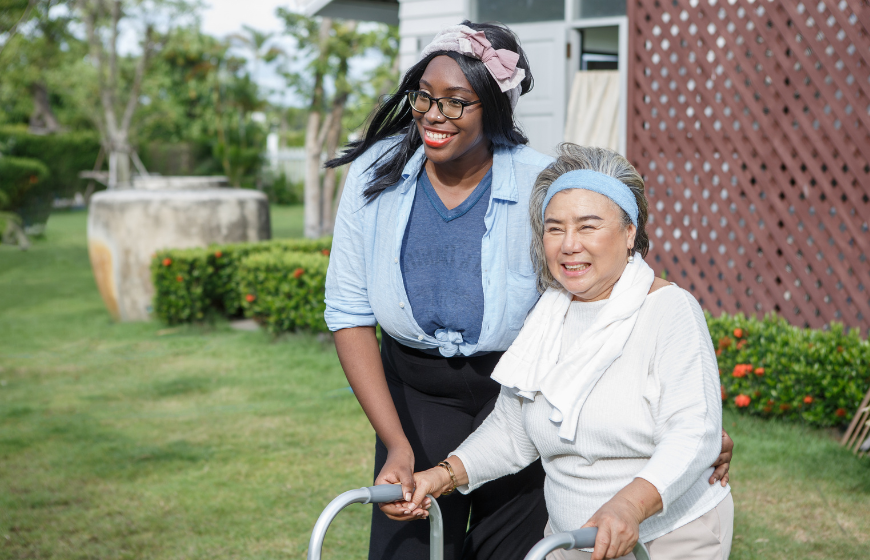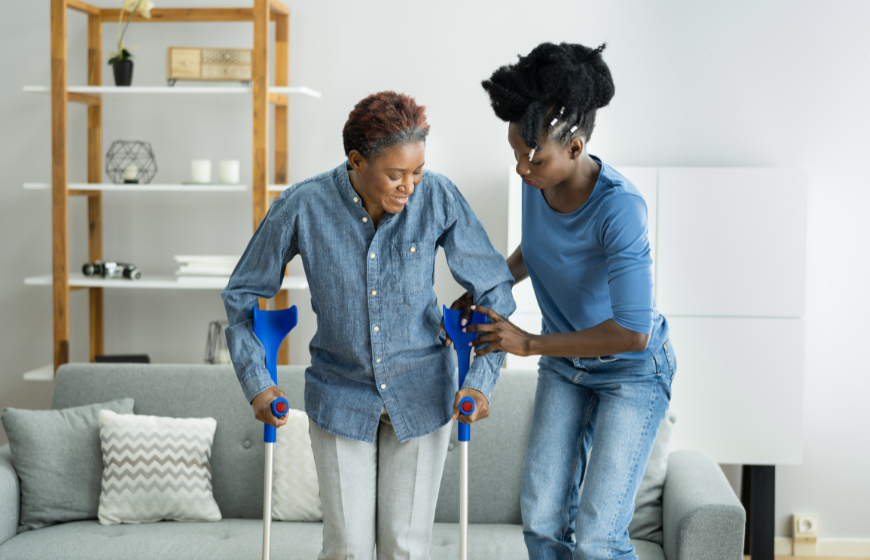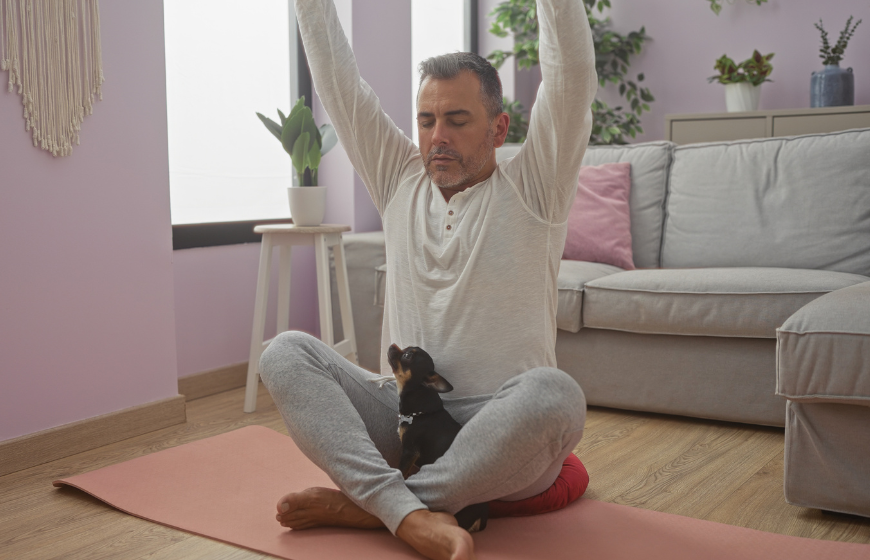Whether a loved one has recently experienced a balance-altering injury like a stroke or you’re simply trying to help an elderly relative strengthen their body, balance exercises make an excellent addition to an elderly person’s day-to-day life.
For anyone trying to stay sharp in their old age, our guide to balance exercises for seniors will provide tips, tricks, and pointers for maintaining (or rebuilding) good balance. Seniors can perform these physical activity exercises alone or with the help of a home medical assistance specialist—in either case, they’re sure to strengthen muscles and refine overall balance.
We’ll cover muscle strength exercises for seniors who walk without an assistive device, strategies for elders who do, and movements that work for just about everyone.
Exercises for Seniors without an Assistive Device
If the senior in your life walks without the help of a cane or a walker, but still occasionally becomes off-balance, the following physical activity exercises for elderly folks could help them build muscles and regain crucial balance control skills.
#1 Tai Chi
Tai chi is a gentle martial arts practice that strengthens muscles, improves flexibility, and bolsters dynamic balance. Often called “meditation in motion,” tai chi is a low-flow practice consisting of constant, gentle movement through a variety of postures.1
It’s a popular exercise program among elderly people for a couple of reasons:
- During tai chi, practitioners don’t flex their muscles—they keep their muscles relaxed throughout each simple exercise movement.
- Movements don’t require the bending or hyperextension of joints.
While practitioners shift their weight between each foot, move their arms, and shift into different poses, they’re strengthening their core to create fluid movement—two crucial elements of creating and maintaining excellent balance control.
While there are likely tai chi courses available outside of their homes, seniors can also find instructional simple exercise videos online.
#2 Heel-Toe Walking
Heel-toe walking—sometimes called balance beam walking—is a balance-building regular exercise that can be modified for a variety of difficulty levels. Thus, it’s an excellent technique to build balance throughout a recovery process or as patients continue to age.
Heel-toe walking is easy and doesn’t require any specialized equipment or instruction. Simply stand in a room clear of obstructions, start with your feet planted hip-width apart, and take a step forward. As you take your next step, place your other foot immediately in front of your first, touching the heel of your second foot directly against the toes of your first. Repeat the process until you’ve crossed the room.
There are a few ways to enhance this regular exercise depending on your current balance training skills:
- If you’re having trouble balancing without a guideline, place a line of tape or string across the floor, using it to guide your steps.
- Place your arms out beside you or in front of you to help you shift your weight if you start to wobble.
- Perform the strength training exercise along a wall, keeping one hand on the wall at all times for support.
Once you can cross a room without difficulty, wobbling, or relying upon a string or tape guide, try it with your eyes closed (while supervised by someone else) for the ultimate dynamic balance test.
#3 Yin Yoga
One of the lowest-impact yoga practices, Yin yoga is the perfect physical and meditative practice for seniors looking to improve their balance. While Yin yoga is relaxing and encourages peace of mind, it also builds strength, particularly of connective tissues.
One of the foundational principles of Yin yoga is the importance of strengthening your body’s connective tissues, which begin to weaken as we age. Yin builds connective tissue strength by stretching these tissues.2
Why should seniors focus on strengthening their connective tissues? These tissues are crucial to joint function, and major joints like the knees, ankles, and hips play a major role in helping us maintain balance. We use our knees, ankles, and hips every day, and seniors who stand up and sit down many times a day rely upon these critical joint groups.
While Yin yoga is excellent for balance, it can also quiet the mind—a particularly useful skill, especially after a traumatic medical incident like a stroke.
Exercises for Seniors with a Walker or Cane
One of the benefits of home care is that seniors have assistance while walking, whether or not they’re using an assistive device. But, even seniors using additional walking tools should maintain balance to prevent falls and improve their walking capacity.
#1 Leg Raises
Leg raises are an excellent balance exercise for seniors using a walker or cane. While unassisted senior walkers could risk a fall while standing on one leg, walker or cane users always maintain at least one additional point of stability while holding onto an assistive device.
You can perform leg raises in a variety of ways:
- While standing with your walker or cane, place your weight on one leg. Slowly raise your leg directly off of the ground, as if you’re going to march. Hold the position for ten seconds (or as long as you can), take a short rest, then repeat with the other leg.
- You can also raise your legs to the side or the back, holding the position for the same duration and resting between each rep.
- To do forward leg raises, walker users may find it easier to stand facing away from the front of the walker to extend their legs without kicking it. Make sure to maintain two points of contact with your hands on the walker as you turn around to prevent falls.
While it might not be a particularly innovative exercise, each rep gives seniors a chance to build both balance and confidence in holding their weight on one leg.
#2 Chair Yoga
For seniors who use an assistive device, walking can be a strenuous activity. Seated exercises—like chair yoga—can also be useful for building strength and maintaining healthy joints, which are both crucial for building and maintaining balance skills.
There are countless chair yoga positions, plenty of which engage the lower body as well as the shoulders, arms, and core. The gentle, seated movements of chair yoga take the pressure off of muscles, which is crucial for joint stretching and lubrication, both of which improve joint strength.3
Like tai chi, chair yoga sessions are widely available online, so seniors seeking a relaxing balance-building regimen don’t even need to leave home.
Balance Exercises for All Seniors
Whether they walk unassisted or with a cane or walker, the following balance exercises for seniors build strength and confidence for walking and standing. The following three exercises have something to offer for everyone.
#1 Single-Limb Stances
Similar to leg raises, single-limb stances challenge seniors to stand on one leg. While traditional single-limb stances call for standing on one foot with your arms by your sides, this exercise is easily modified for seniors:
- Placing one or two hands on a stable chair—not a rolling chair—or countertop for assistance
- Holding the position for longer and longer durations to progressively build muscle control and strength
- Crossing the raised foot in front of the opposite leg for an added balance challenge
- Circling the ankle of the raised foot for ankle joint stretching and an added flexibility exercise
Single-limb stances are some of the most versatile balance exercises for elderly people. Poses with scalable difficulty are perfect for balance recovery after a stroke or fall.
#2 Core Exercises
Core strength is crucial for balance. The core muscle group helps keep the body upright and regain stability in the event of a stumble.
Seniors can try a variety of core exercises to improve their balance:
- Twists – While standing or seated, square your shoulders directly above your hips. With hands held out in front of you, slowly twist your body to the right side, keeping your hips and legs as stationary as possible. When you’ve twisted as far as you can without moving your lower body, hold the position for five seconds before repeating the motion on the other side.
- Oblique crunches – Align your shoulders with your hips while seated or standing. Hinge your body to one side while keeping your shoulders facing forward and without moving your legs. Hold the position for five seconds, then repeat on the other side.
- Seated bows – Sit down on the floor or a couch with your legs out in front of you. Raise your arms over your head, and hinge at the waist as far as you comfortably can while keeping a straight back. Hold the position for three seconds, and slowly raise your chest back up to a seated position.
As always, make sure to complete standing exercises with supervision, and hold onto a steady chair, wall, or countertop if needed.
#3 Toe Stands
While cane or walker users can do this exercise simply with the help of their assistive devices, seniors who walk unassisted will want to place their hands on a countertop, table, or mantel.
Starting with your feet flat on the floor, slowly raise your heels, shifting your weight to your toes. Hold the position for as long as you can, aiming for ten seconds. Slowly lower your heels back to the starting position, rest for a few seconds, and repeat the exercise.
Toe stands strengthen calf muscles, which aid in walking stability, reducing the likelihood of trips and falls.
Balance Your Elder Care Plan with Alliance HomeCare
If a senior loved one in your life isn’t as strong as they used to be, or if they’re recovering from a balance-altering accident like a fall or a stroke, the balance exercises above can help them regain critical skills. Improved balance makes everyday tasks like walking, standing, and sitting significantly easier and safer and, in many cases, reduces the likelihood of slips and falls.
Between understanding the causes of a stroke in the elderly to learning about life expectancy after a stroke at 70, caring for a family member who has suffered from a stroke can be difficult. At Alliance Homecare, our experienced, knowledgeable, and compassionate home nurse care staff are here to help you in every step of your elder care journey.
Our team members embody integrity and professionalism, and we provide the care your loved ones need in the most comfortable, supportive environment—at home.
Contact our care team today.
Sources:
- Harvard Medical School. The Health Benefits of Tai Chi. https://www.health.harvard.edu/staying-healthy/the-health-benefits-of-tai-chi
- Yoga Journal. Why Try Yin Yoga? https://www.yogajournal.com/yoga-101/types-of-yoga/yin/yin-yoga-2/
- Healthline. 7 Yoga Poses You Can Do in a Chair. https://www.healthline.com/health/fitness-exercise/chair-yoga-for-seniors
